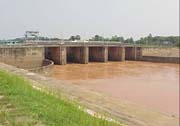While surface irrigation methods rely on watering the whole surface of the field and overhead irrigation leaves the plants wet and produces runoff, drip irrigation is far more controlled. Water is slowly provided to a very specific area, close to the roots of the plant, by a network of drip emitters.
 Photo courtesy USDA ERS Drip Irrigation |
Despite their name, these tiny nozzles - about the size of a quarter - don't hang above the plants and drip but are actually laid along the ground. Linked to an appropriate water source by a main feeder hose, they provide a slow and steady flow of water. An alternative to drip irrigation is trickle tape - essentially a length of hose with built in drip emitters.

2008 HowStuffWorks
Drip irrigation provides water near the base of the plant, leaving the upper foliage dry and less susceptible to fungi.
The advantage to using trickle or drip irrigation is, simply, control. This method of irrigation is precise an d economical. A standard lawn sprinkler (Contech Electronics CRO101 Scarecrow Motion-Activated Sprinkler ), for example, might measure the water flow in gallons per minute -- somewhere between one and five is normal. A drip emitter, on the other hand, is rated in gallons per hour. The flow of water is so slow that it is easily absorbed into the ground. In a well-tuned system there is little opportunity for excess water running off and being wasted.
), for example, might measure the water flow in gallons per minute -- somewhere between one and five is normal. A drip emitter, on the other hand, is rated in gallons per hour. The flow of water is so slow that it is easily absorbed into the ground. In a well-tuned system there is little opportunity for excess water running off and being wasted.
And this approach can be even more fine-tuned by going underground.
sprinkler
drip irrigation
Books



